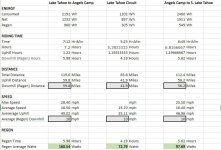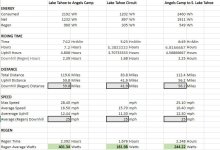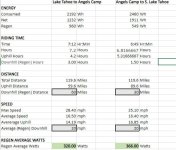So long as this thread is about regen braking now, ehehe, here is a great resource to very accurately calculate your desired braking power:
https://www.gribble.org/cycling/power_v_speed.html
You'll need to ascertain your CdA and CRR though, but you can approximate it using reference data.
Regarding low regen percentage: if you rarely brake at all, you'll get no regen, duh.
A light bicycle with terrible aerodynamics is, indeed, pretty poor candidate for regen - you'll hardly 'outregen' even no-load losses when you pedal the bike w/o assist, unless your road is all 'steep up/twisty down'. Than regen is a godsend.
Something like a heavy velomobile is a much better candidate, but typical e-bike DD motors are very heavy and have extremely high heat losses, and relatively thick laminations mean pretty high no-load losses.
A motor that will output a torque similar to a good bicycle brake (about 100nm) will do it at very low efficiency and overheat very quickly, and/or will be very heavy and have high no-load losses, hence will be hateful to pedal w/o assit (unless you go the way of grin and add constant assist even with zero throttle, but that is still losses...) - or will have to come in a form of fixed gear middrive with high mechanical reduction (returning to the original point of this thread).
A 'holy grail' of high-efficiency motor assist with regen, but zero iron losses would be either switched reluctance motor (it has it's downsides), or a system that has manual clutch with a neutral gear, in a form of a middrive with high reduction ratio that is independent from bicycle transmission (or a friction drive, I intend to experiment with that).
However, using recuperation as *emergency braking* is an overkill I think, unless you are building what amounts to an electric motorcycle. It is best used to scrub speed indeed. This is more efficient on motor, on battery and emergency braking (hopefully) does not happen very often and conventional brakes indeed to it well enough.
This way an efficient fixed gear middrive with low no-load losses but pretty high 'ampacity' will be able to provide high-speed assist and speed scrubbing, assist in climbing steep stuff/brisk accelerations will be provided by a motor with an overruning clutch, likely 'crankdrive'.
I'm testing such a system right now, still need some kinks to iron out but works pretty good for my purposes:
An other benefit of middrive - you are no longer limited by dropout design.






